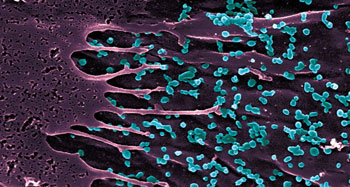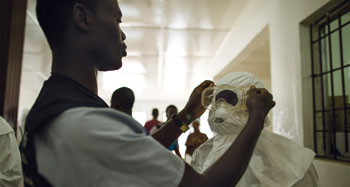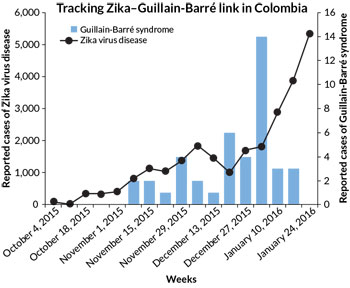Teachers make time for Ebola and other current events
Science teachers who cover current topics in the classroom struggle to find time and resources

Worrisome current events, such as the Ebola outbreak in 2014, provide educators new opportunities in the classroom.
monkeybusinessimages / iStockphoto
The 2014 Ebola outbreak triggered a flood of misinformation that worried students and parents alike.
“Students were very concerned about the outbreak and the treatment center here,” says Kim Hansen in Omaha, Neb. She is a social studies teacher there at Christ the King Catholic School. At the time, local medical experts were treating U.S. Ebola cases, bringing the epidemic close to home.
“Some [students] were irrational about it and feared everyone in Omaha would die,” Hansen recalls. So she took time out of class to look up statistics with her students. Together, they learned that “the possibility of an outbreak happening here was minimal.” Arming her students with that information helped to allay some of their fear, she says.
It’s a common situation in classrooms: Students come in with concerns about events they have heard about on the news or online. Among teachers, many — if not most — feel compelled to find a way to address those concerns, even when the topic doesn’t fit into the curriculum.
A new report points to how many teachers tackle such issues that can emerge unexpectedly.
Burning questions
Events like the Ebola outbreak offer an important opportunity to dispel worries and fears, replacing misinformation with fact, says Sean Smith. He’s president of Horizon Research, an organization focusing on STEM education in Chapel Hill, N.C.
“There is a multiplier effect,” he says. Usually, when an individual checks out information from the website of the Centers for Disease Control and Prevention (CDC), what they learn goes no further. “But if a teacher goes to the CDC site, he or she will share that information with 20 to 100 more people.” Concludes Smith, that makes the classroom an ideal location to spread reliable information about current events.

With help from the National Science Teachers Association, they recruited K-12 teachers from across the United States. The questionnaire asked whether students had come to the teachers with questions about Ebola, and whether the teachers had addressed the outbreak in class. It also asked teachers what activities they used to discuss Ebola, and what resources they drew upon to design those activities.
Overall, 1,255 teachers responded. More than 75 percent of middle- and high-school science teachers reported that they had carved out time to talk about Ebola — even though it was not part of their schools’ curriculum. Most of those teachers spent more than one class period on the subject.
Among elementary teachers, just under half covered Ebola. Those who did usually spent only one class period. Teachers who did not cover it often deemed the topic inappropriate for their students. Smith suspects this perceived inappropriateness traced to Ebola’s frightening symptoms.
The biggest factor motivating teachers to squeeze Ebola into their lessons was student interest. Teachers reported that they needed to take up the outbreak simply because students could concentrate on little else.
“We talk about Ebola and swine flu and every illness that makes the news,” says Kathy Nida. She teaches life science to seventh graders at Cajon Valley Middle School in El Cajon, Calif. “The kids come to me with their topics and worries,” she says. “They’ll ask about [a topic] even when it’s not relevant to what they’re learning.”
When diving into such current events, Nida and her co-teacher often have their students start by researching the topic themselves. “Sometimes we give them a specific article or articles to read,” Nida says. “Sometimes we give them a few links. Sometimes we just send them out into the wild, wild Internet to figure it out on their own.”
Finding the time
Nida has encountered two major obstacles in helping students learn about current events: lack of appropriate resources and too little time. “It’s hard to find good, kid-friendly websites for these more difficult topics that are at the reading level of my students,” she says.

“I like to use articles not specifically aimed at a student population,” says Jolene Pappas, a life-science teacher at Batavia High School in Ohio. These prepare them, she says, “more for the ways they will consume information from the media as an adult.” However, she would also like to see age-appropriate resources for her students for lower-level students. Pappas says she would like to have access to such articles that contain good science and do not sensationalize topics. And reading guides would be a plus. “Either time to prepare these resources myself or a quick way of finding materials that can be used or modified would be helpful,” she adds.
Susan Paulsen, a geology and environmental science teacher at Live Oak High School in Morgan Hill, Calif., recommends Science News for Students (SNS) as a resource for timely science topics. “It’s a concentrated place where I know my students can find the information they need,” she says. “Articles are current, accurate, and accessible to their reading level,” she notes. “And,” she adds, “it’s free!”
Even with good resources in hand, the Horizon survey found, finding time to cover the topics was a challenge. Of the teachers surveyed by Horizon who did not cover Ebola, about two-thirds said lack of time influenced their decision.
“It is sometimes difficult to integrate a current event into a class design,” Pappas says. She discussed Ebola in all of her classes. Sometimes topics like this fit into the curriculum, she says. “Other times, including a current event means taking a time-out from our current topic.”
In such situations, teachers can focus on “nature of science” or “science practices” curriculum standards, says Pasley. “Science education is about students learning to make evidence-based decisions,” she points out. Having students research a current topic and make decisions based on what they find can allow teachers to fit the subject into an otherwise tight lesson plan.

Teachers who belong to NSTA can sign up for its listservs, he says. These allow teachers to discuss sources of information or effective activities. “Last I checked, I saw five [discussion] strands on Zika,” he notes.
Zika is likely to be the next health topic capturing the country’s attention. And it may have an even bigger impact on students. “Zika is carried by the same mosquito as Dengue fever,” Evans says. Compared to Ebola, “It’s much closer to home for students in the United States.” That is particularly true for those in southern states close to Central America and Mexico — the latest reported locations for the disease.
Zika offers some great opportunities for teaching, in addition to dispelling student worries, Evans says. “Students can learn about the nature of diseases, the spread of the mosquito, and vectors.” By using the classroom to focus discussion, he says students can learn about the disease without fear.
Power Words
(for more about Power Words, click here)
Centers for Disease Control and Prevention, or CDC An agency of the U.S. Department of Health and Human Services, CDC is charged with protecting public health and safety by working to control and prevent disease, injury and disabilities. It does this by investigating disease outbreaks, tracking exposures by Americans to infections and toxic chemicals, and regularly surveying diet and other habits among a representative cross-section of all Americans.
chikungunya A tropical disease that has been crippling large numbers of people in Africa and Asia. It’s caused by a virus that is spread by mosquitoes. It recently has been spreading widely throughout warm nations. More than 3 million people have suffered through its initial flu-like symptoms. A large share may also go on to develop intense pain in their muscles and joints that can last months to years. There is no cure or vaccine.
Ebola A family of viruses that cause a deadly disease in people. All cases have originated in Africa. Its symptoms include headaches, fever, muscle pain and extensive bleeding. The infection spreads from person to person (or animal to some person) through contact with infected body fluids. The disease gets its name from where the infection was first discovered in 1976 — communities near the Ebola River in what was then known as Zaire (and is now the Democratic Republic of Congo).
National Institutes of Health, or NIH This is the largest biomedical research organization in the world. A part of the U.S. government, it consists of 21 separate institutes — such as the National Cancer Institute and the National Human Genome Research Institute — and six additional centers. Most are located on a 300 acre facility in Bethesda, Md., a campus containing 75 buildings. The institutes employ nearly 6,000 scientists and provide research funding to more than 300,000 additional researchers working at more than 2,500 other institutions around the world.
World Health Organization An agency of the United Nations, established in 1948, to promote health and to control communicable diseases. It is based in Geneva, Switzerland. The United Nations relies on the WHO for providing international leadership on global health matters. This organization also helps shape the research agenda for health issues and sets standards for pollutants and other things that could pose a risk to health. WHO also regularly reviews data to set policies for maintaining health and a healthy environment.
Zika virus A virus that can be transmitted to humans via mosquitoes. About 20 percent of infected people get sick. Symptoms include a slight fever, rash and pinkeye and usually fade quickly. A growing body of evidence suggests that the virus could also cause a devastating birth defect — microcephaly. Evidence suggests it may also cause neurological conditions such as Guillain-Barré syndrome.







